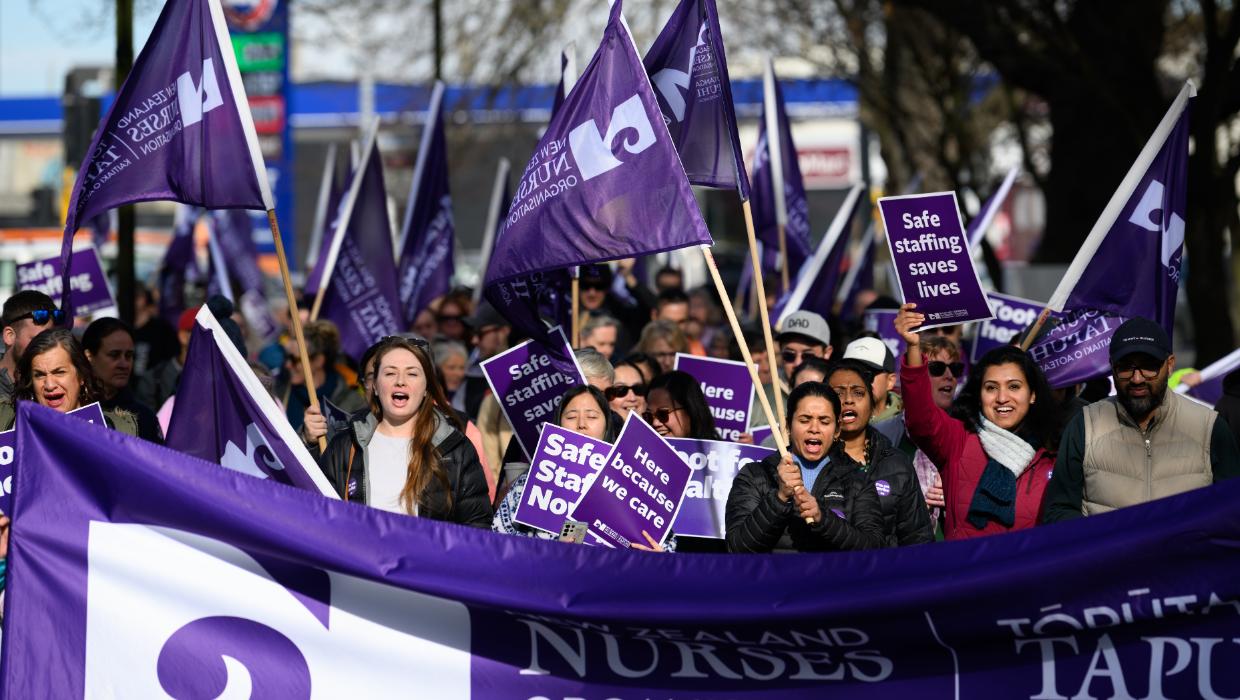Business
Major Strike Scheduled as 110,000 Health and Education Workers Mobilize

A significant strike involving over 110,000 unionized health and education workers is set to take place on October 23, 2023. This mass walkout represents a critical moment for both the government and the unions as they navigate a complex landscape of public support and economic challenges. The impending strike could be the largest in recent decades, with both sides keenly aware of the potential repercussions on public services and their respective positions.
Government Faces Pressure Amid Economic Challenges
The New Zealand government, led by Health Minister Simeon Brown, is facing mounting pressure as the strike approaches. Brown recently made a final attempt to avert the situation by warning of potential cancellations for patients if the strike goes ahead. At a conference last month, he received a lukewarm response from nurses despite efforts to adopt a less confrontational approach. However, this week, during a meeting with senior doctors, he adopted a more combative stance, suggesting that the strike could cross an “ethical line” by adversely affecting patient care.
Brown’s comments elicited audible reactions, highlighting the tension between the government and healthcare professionals. Following a query about restricting strike actions in critical services, he stated, “If strike action continues, that may well have to be something that is considered.” This statement was met with concern from Fleur Fitzsimons, national secretary of the Public Service Association, who described it as a “deeply troubling threat.” The Minister’s office later clarified that he was not proposing any legal changes, but emphasized the need to ensure the continuity of essential health services.
Unions Mobilize for Collective Action
On the education front, a minor victory occurred when the Primary Principals’ Collective Bargaining Union, representing around 500 members, reached an agreement with the government. Yet, this settlement only represents a small fraction of the nearly 60,000 education workers planning to participate in the upcoming strike. Public Service Commissioner Sir Brian Roche noted that this agreement demonstrates the potential of effective, good faith bargaining.
Historically, large-scale strikes are not a new phenomenon in New Zealand. Teacher unions previously united under the last government to demand better conditions, and nurses have voted to strike in 2018 and 2021. The scale of the workforce participating in the October strike indicates a significant shift, as it comprises members typically required to negotiate after an expired agreement for at least 40 days.
Dr. Grant Morris, a legal history expert from Victoria University, identified two distinct trends over the past 25 years regarding strikes. He observed that unions often strike under Labour governments due to a more favorable negotiating environment. Conversely, a lack of patience with National-led governments can prompt strikes, particularly as economic conditions worsen. Morris emphasized that the current cost of living crisis is a crucial factor, as economic instability hampers the government’s ability to meet employee demands.
As the strike date draws near, the economic implications are becoming increasingly apparent. Brad Olsen, chief executive of Infometrics, stated that a mega strike day would disrupt economic efficiency significantly. He noted that the objective of a strike is to exert pressure and leverage for negotiations, which may not always yield the desired results. Olsen added that public sentiment surrounding the negotiations is complex, with no clear indication of which side is winning the public battle.
Labour MP Jan Tinetti, who has extensive experience on both sides of the negotiating table, reflected on the challenges arising from the current situation. Having transitioned from a unionist to a government minister, she acknowledged the different perspectives involved in negotiations. Tinetti pointed out that effective communication and understanding between both parties could lead to more productive outcomes.
As the public awaits the outcome of these discussions, it is clear that the impending mega strike is the culmination of ongoing negotiations that have garnered attention for months. With both sides holding firm, the situation remains tense, and the impact on public services and the economy will be closely monitored in the coming days.
-

 World1 week ago
World1 week agoPrivate Funeral Held for Dean Field and His Three Children
-

 Top Stories2 weeks ago
Top Stories2 weeks agoFuneral Planned for Field Siblings After Tragic House Fire
-

 Sports3 months ago
Sports3 months agoNetball New Zealand Stands Down Dame Noeline Taurua for Series
-

 Entertainment3 months ago
Entertainment3 months agoTributes Pour In for Lachlan Rofe, Reality Star, Dead at 47
-

 Entertainment2 months ago
Entertainment2 months agoNew ‘Maverick’ Chaser Joins Beat the Chasers Season Finale
-

 Sports3 months ago
Sports3 months agoSilver Ferns Legend Laura Langman Criticizes Team’s Attitude
-

 Sports1 month ago
Sports1 month agoEli Katoa Rushed to Hospital After Sideline Incident During Match
-

 World3 weeks ago
World3 weeks agoInvestigation Underway in Tragic Sanson House Fire Involving Family
-

 Politics2 months ago
Politics2 months agoNetball NZ Calls for Respect Amid Dame Taurua’s Standoff
-

 Top Stories2 weeks ago
Top Stories2 weeks agoShock and Grief Follow Tragic Family Deaths in New Zealand
-

 Entertainment3 months ago
Entertainment3 months agoKhloe Kardashian Embraces Innovative Stem Cell Therapy in Mexico
-

 World4 months ago
World4 months agoPolice Arrest Multiple Individuals During Funeral for Zain Taikato-Fox


















